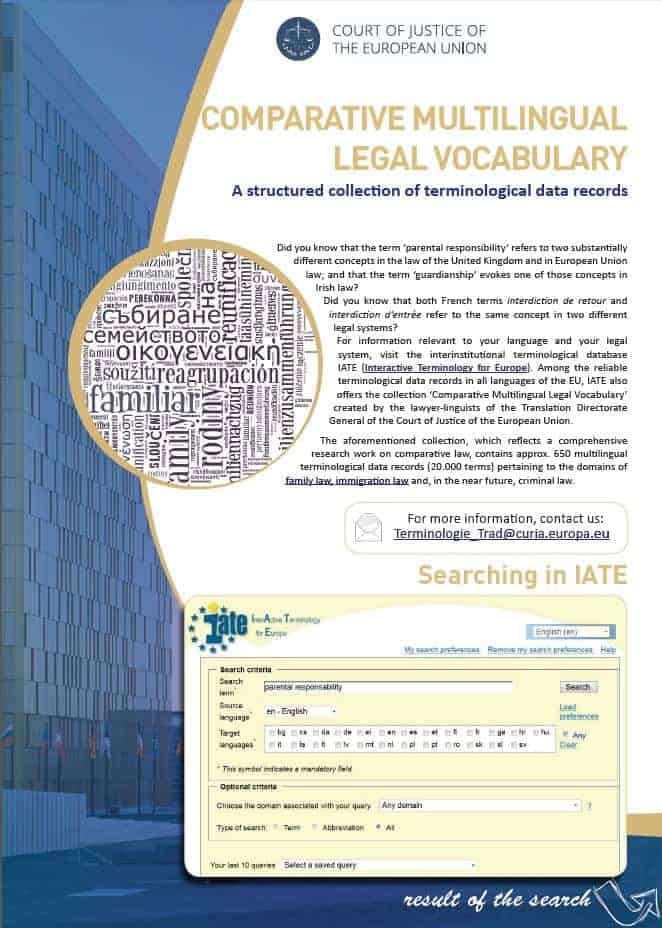Collection of multilingual terminological data records and multi-systems (more than 23 languages and 30 EU legal systems) resulting from a comprehensive research work on comparative law done by the lawyer-linguists of the Translation Directorate General of the Court of Justice of the European Union.
The terminological data records have very detailed information such as definitions (adapted to each legal system), notes on comparative law, legal references (legislation, case law, doctrine of national, EU and international legal systems), the different designations of a concept (in the same language and sometimes different according to the legal systems), a clear indication of the origin of a term (functional equivalent or formulation —paraphrase), warnings (false legal friends, risk of confusion, obsolete terms), concept trees allowing to see at a glance the semantic relationships between concepts, etc.
More …
• VJM at a glance
• List of multilingual terminological data records : Immigration Law | Family Law
• Concept trees:
Immigration Law
Family Law: Filiation | Matrimonial Law | Family situation
For more information, contact the team in charge of the project at the Translation Directorate General of the Court of Justice of the European Union. Mailto: Terminologie_Trad@curia.europa.eu
At the end of 2008 the Publications Office of the European Union (PO) proposed that, within the framework of the interinstitutional project e-Justice, the Translation Directorate General (DGTrad) of the Court of Justice of the European Union contribute to the creation of a comparative multilingual legal vocabulary (‘VJM’) for the various legal systems of the Member States of the European Union.
Taking form in 23 languages, the aim of the VJM was to make available to lawyers and EU citizens a multilingual documentary tool for indexing and searching the documentary resources of the national legal databases. To provide an answer based on concrete facts, DGTrad decided to initiate a feasibility study and began working on VJM in March 2009. In this context, DGTrad proposed to produce an atypical controlled vocabulary, which would make it possible to respect two imperatives: finding information (the documentary requirement) and understanding it (the terminological requirement). Currently, VJM covers the domains of immigration law and family law. Criminal law is under preparation.
 The lawyer-linguists who worked on the project did extensive research in comparative law (national, EU and international law), which required a very detailed analysis of the different legal concepts specific to each legal system, as well as of the different designations of a concept within each system in legislation, jurisprudence and doctrine.
The lawyer-linguists who worked on the project did extensive research in comparative law (national, EU and international law), which required a very detailed analysis of the different legal concepts specific to each legal system, as well as of the different designations of a concept within each system in legislation, jurisprudence and doctrine.
That comparative legal analysis has produced a coherent and hierarchically structured set of terminological data records containing terms accompanied by reliable references, contexts, various notes (historical notes, comparison of laws, evolution of concepts, guidance on the use of terms, etc.), definitions, contexts illustrating the use of various terms in practice, semantic relations, etc. In addition to the terminological data records, a common concept tree is available for each domain.
In June 2010, DGTrad delivered the report on the feasibility study to the PO. This report and a summary of the conclusions were presented in November 2010 to the Group e-Law (Training e-Justice) of the Council.
This project brings numerous benefits and especially in the context of translation of urgent requests for preliminary ruling. As a matter of fact, the work done allows lawyer-linguists to save time as well as to provide high-quality translations thanks to a greater harmonization of terminology within translations. Therefore, the value of continuing with this approach —if conditions allow— in other legal domains, which are frequently subject of proceedings before the courts of the European Union, is now established in DGTrad.
VJM contains at present about 647 terminological data records: 243 in the domain of immigration law and 404 in family law and soon 400 in criminal law. Both collections have been imported into the interinstitutional terminological database IATE. This vocabulary can be useful to anyone (citizens, legal professionals, students, linguists, terminologists, translators) as a source of information or terminological support (translation assistance or simply for comprehension).
